This is the mysterious device that Croatian fishermen pulled from the Adriatic Sea before the US military demanded they hand it over.
The device was ‘caught’ between the island of Mljet and the island of Sveti Andrija, part of the Elaphiti Islands archipelago in the Adriatic Sea in Croatia by fishermen on board the Marian II fishing vessel.
The large orange box which measures around 130 centimetres (51 inches) in diameter and weighs around 100 kilogrammes (220 lbs) reportedly ripped through the fishermen’s nets. Fisherman Darko Kunac told reporters that the mystery device caused 20,000 HRK (2,281 GBP) of damage to his nets.

He reportedly confirmed that he was contacted through radio on VHF channel 16 by a US military ship asking for the device back.
He said: “They called me through VHF. With them was the Croatian Coast Guard. They want me to give it back to them, but I won’t until they pay for the damages.
“They called me again on the radio station, and in the end on my mobile phone.
“Then the harbour caption from Dubrovnik called and they told him to tell me to return it and they would compensate me for the damage.”
According to local media outlet Morski.hr, there is a document confirming that the device arrived in Croatia in November from the address of NASA’s Stennis Space Centre in south Mississippi.

Reports state the American and Croatian key authorities – such as the Ministry of Defence – are familiar with the reason why the device is there but cannot comment on it for the media. Local media sources could only reveal that the sender’s address is Maritime tactical control which is the owner of the device.
Kunac said: “We unloaded the hellish device, I handed it over a while ago. They paid me the damages, everything was fine in the handover.
“Those Americans thought that I was some Somalian pirate, or who knows what, they thought I was on drugs and that I would take millions from them. But I told them I’m not interested in that, that I have my brain and that they will not play with me. I threatened them that I would throw the device in the sea and that I was a tough nut.”
An unnamed expert who worked on the technical systems and a former Croatian Navy employee told Morski.hr: “This is a HIPAP acoustic underwater positioning and navigation system, whose battery life is 16-102 days, depending on the transponder mode.”

A reply from the Ministry then reportedly arrived: “The Ministry of Sea, Transport and Infrastructure has issued an approval for the testing of marine research equipment and devices by the research vessel Bruce C. Heezen of the United States Navy.”
To find out more about the author, editor or agency that supplied this story – please click below.
Story By: Angjela Trajkovska, Sub-Editor: Joseph Golder, Agency: Central European News
The Ananova page is created by and dedicated to professional, independent freelance journalists. It is a place for us to showcase our work. When our news is sold to our media partners, we will include the link here.




